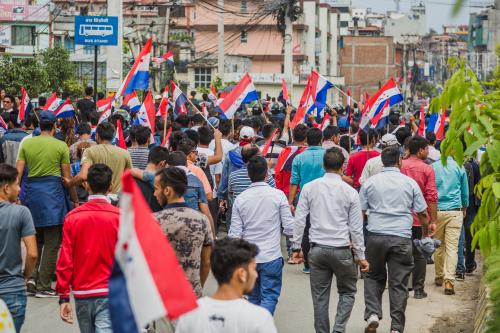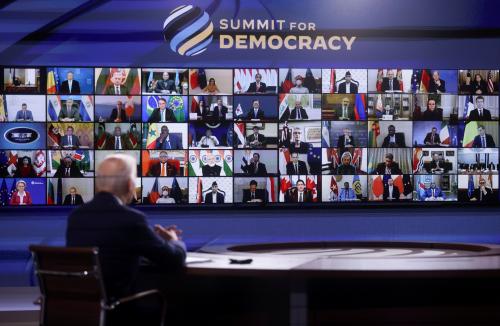In early 2023, the United Nations announced that the world is facing the highest number of violent conflicts since World War II, with a majority of these being civil conflicts. Historically, ending civil conflict and fostering democratic transitions has involved constitutional reforms that address the grievances that originally sparked violence. In fact, over 100 peace agreements signed between 1989 and 2020 have included provisions for constitutional reform. However, the period of negotiating constitutional reforms is particularly precarious in such settings and can lead to further destabilization if too many groups’ expectations are not met.
Sure bets versus risky gambles in constitutional negotiations
In a new working paper focused on Nepal, we examine why different communities possess varying attitudes toward constitutional reforms in post-conflict contexts. We draw on a theory from psychology called prospect theory, which emphasizes that individuals’ preferences over a policy outcome do not simply align with their actual concrete gains and losses. Instead, people tend to take larger risks, or risky gambles, if they perceive they have nothing to lose. Yet, they are more likely to be cautious and accept the “sure bet” if they perceive they have already secured significant gains that they do not want to jeopardize. These calculations are particularly pronounced in contexts of high uncertainty, such as those that prevail in post-conflict settings.
These risk calculations depend on how individuals view the primary purpose of a new post-conflict constitution. For some, post-conflict constitutions represent the end of a traumatizing and violent time period. Promises to reform political systems through new constitutions can be essential to convincing elites from previously warring factions to lay down arms and compete for power in elections rather than on the battlefield. Citizens most affected by long-lasting instability and violence may view such post-conflict institutions with relief and as a sign that the conflict is over. For others, post-conflict constitutions mark the beginning of a new and more inclusive political settlement and an opportunity for citizens previously marginalized to gain representation and voice, often for the first time. Indeed, all citizens will have to live by the rules of the new constitution—not just the previously warring factions—and therefore, for this group, the constitution’s role in democratization and political inclusion is more salient than its role in ending civil war.
While each of these roles—ending conflict and launching a new era—may seem like two sides of the same coin, they have dueling timelines and political implications. With ending conflict in mind, there is a primacy on quickly getting to a resolution to fully close the chapter on conflict and instability because lengthy negotiations risk renewed violence. Designing political institutions and administrative units that do not result in too much power for a single group can be seen as essential for diffusing tensions and reducing the salience of the social divisions that may have originally spurred conflict. By contrast, with a new political era in mind, lengthy negotiations are desirable rather than risky because they increase the likelihood that everyone’s voices have been heard, especially the voices of women and previously marginalized groups who are often missing from elite-driven peace negotiations. Designing political institutions and administrative units that ensure group representation can be seen as essential for ensuring that minority ethnic groups experience autonomy and have a voice in the new era.
Citizens’ views of Nepal’s 2015 constitution
Drawing on the case of Nepal, we examine these dual roles and their implications for citizen perceptions of the post-conflict constitution. Nepal’s 2015 constitution both closed the chapter on Nepal’s 10-year civil war—fulfilling a key provision of the Comprehensive Peace Accord signed in 2007—and launched Nepal into a new era of democracy and greater political inclusion. To understand how ordinary citizens viewed the new constitution, we conducted a survey of over 1,000 respondents across rural Nepal several months after the constitution was promulgated. We implemented a secret ballot mock referendum, asking respondents to indicate whether they would have voted to support the new constitution. We further asked their opinions on the lengthy and contentious process of negotiating and promulgating the constitution, which was led by a constituent assembly comprised of political elites. Among other issues, greater subnational autonomy for certain ethnic groups was a major area of debate.
We focus on three key groups: citizens exposed to civil war violence, dominant ethnic minorities that had political representation and obtained concessions in constitutional negotiations, and ethnic minorities with lower representation and ultimately fewer concessions. We find that those exposed to more civil war violence saw the constitution as a symbolic end to the violent era and were more supportive of the final document. By contrast, ethnic minorities with lower political representation in the constitutional negotiations and who received fewer concessions were more likely to oppose the constitution and wanted to extend the negotiation period for a more inclusive political settlement. Dominant ethnic minorities with greater representation and who gained some—but not all—of their desired concessions occupied a middle position, conveying concerns about the process but not necessarily opposing the final document.
Broader relevance
Given the concerning state of global insecurity, the findings have broader relevance beyond Nepal. For instance, the U.S. government’s 2019 Global Fragility Act (GFA) and the accompanying Strategy to Prevent Conflict and Promote Stability emphasize strengthening democracy and rule of law as pathways to peace and stability and highlight the importance of “inclusive political processes.” Achieving such inclusivity will require engaging with not only warring parties and the political elite but also uncovering the complex risk preferences of different groups of individuals. For several countries grappling with their own fraught constitutional reform processes, such as Burkina Faso, Chad, Guinea, and Mali, these lessons could have seismic implications for long-term stabilization and democratization in the Sahel. As the Nepal case shows, understanding how ordinary citizens interpret their perceived losses and gains in a new constitution can help identify in advance threats to the durability and the legitimacy of the political settlement that such documents are intended to embody and shed light on the micro-foundations of state-building.








Commentary
Building popular support for post-conflict constitutions: Lessons from Nepal
June 16, 2023